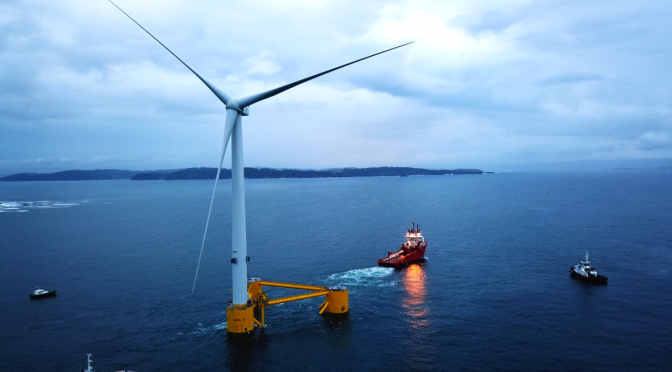The promotion of offshore wind energy is key in the process of transition to climate neutrality, according to a statement from the Ministry for Ecological Transition.
For this reason, the draft Climate Change Law gives a boost to the development of renewable energies, and the Integrated National Plan for Energy and Climate 2021-2030 (PNIEC) is committed to promoting sea energy to reduce its generation costs by support mechanisms for pre-commercial facilities and the R + D + i of new generation testing devices.
In addition, it indicates the high potential of Spain in the offshore wind energy sector with floating technology in the 2030 horizon due to its availability of deep sea waters and its increasing levels of competitiveness, according to the Ministry.
There are few floating facilities in service in the world, with around 65 MW in total, and they are located in Norway, Scotland, France, Japan and Portugal.
Europe is already a leader in offshore wind power worldwide with 22 GW installed at the end of 2019, compared to 6 GW in the rest of the world.
The European Green Pact includes in its development forecasts to achieve climate neutrality the importance of increasing the production of wind energy
marine, the crucial role that the sustainable blue economy and the more sustainable management of the marine space will play, especially in facilitating access to marine renewable energy.
Saitec Offshore Technologies and the Biscay Marine Energy Platform (BiMEP) marine energy testing center have signed the contract for the installation of the DemoSATH prototype on the Basque coast and which will be the first floating wind turbine in Spain.
The Deputy Minister of Industry of the Basque Government and President of BiMEP, Javier Zarraonandia, the General Director of EVE, Iñigo Ansola, and the Director of Operations of Saitec Offshore Technologies, Luis González-Pinto, among others, attended the signing this Friday. of this contract for the installation, for the first time in the State, of a 2 MW real-scale floating wind turbine with 100% Basque technology and power. In the world there are only eight prototypes to scale and of these three are in Europe.
The project will test the country’s first floating offshore wind turbine connected to the grid using SATH technology. In the third quarter of 2021, the start of marine operations is planned. Once operational, it is expected to inject wind energy into nearly 2,000 homes through the electricity grid.
The prototype, equipped with a 2 MW wind turbine, has dimensions of 30 meters wide and 67 meters long. It will be assembled in the Port of Bilbao and, later, it will be installed on the BIMEP testing platform, in a location 85 meters deep, 2 km from the coast in front of the port of Armintza (Bizkaia).
The Director of Operations of Saitec Offshore Technologies, Luis González-Pinto, stressed that it is “a great step” to carry out “this demonstrator on a real scale”.
“This milestone can perhaps be considered as the main cut between the different technologies to access commercialization. As if this were not enough, we have been able to develop this project at home thanks to the existence of an infrastructure such as BiMEP, ready to carry out the installation” , has added.
BiMEP is a public company established in 2011 for the development, construction, operation, maintenance and management of an open sea testing platform whose partners are the Basque Energy Agency, EVE (75%) and the Ministry for Ecological Transition and the Demographic Challenge through the Institute for the Diversification and Saving of Energy, IDAE (25%).
Luis González-Pinto added that the Basque Country has a “very active” industry in this sector and believes that this project may be “the spearhead of the Basque Floating Wind Industry”.
For his part, the technical director of Saitec Offshore Technologies, David Carrascosa, has indicated that the DemoSATH project will not only focus on technological validation, but will also demonstrate the ability to mobilize the industry at a local level.
Specifically, he has referred to the construction of a reinforced concrete SATH platform, which combines civil construction with the wind and naval supply chain. Saitec estimates that at least 70% of DemoSATH’s hiring budget falls to the local industry.
At the appearance, they underlined that the decarbonisation objectives of the energy model and the relevance that renewable energies have acquired in recent years have led to floating wind power having a “promising future and, in turn, presenting itself as a clear protagonist in the transition that society has been demanding “.
In this sense, they have underlined that, taking into account that the majority of the coastal areas in the world have depths greater than 60 meters, floating offshore wind is presented as “the best tool to take advantage of the full potential of the wind to generate energy clean. “


